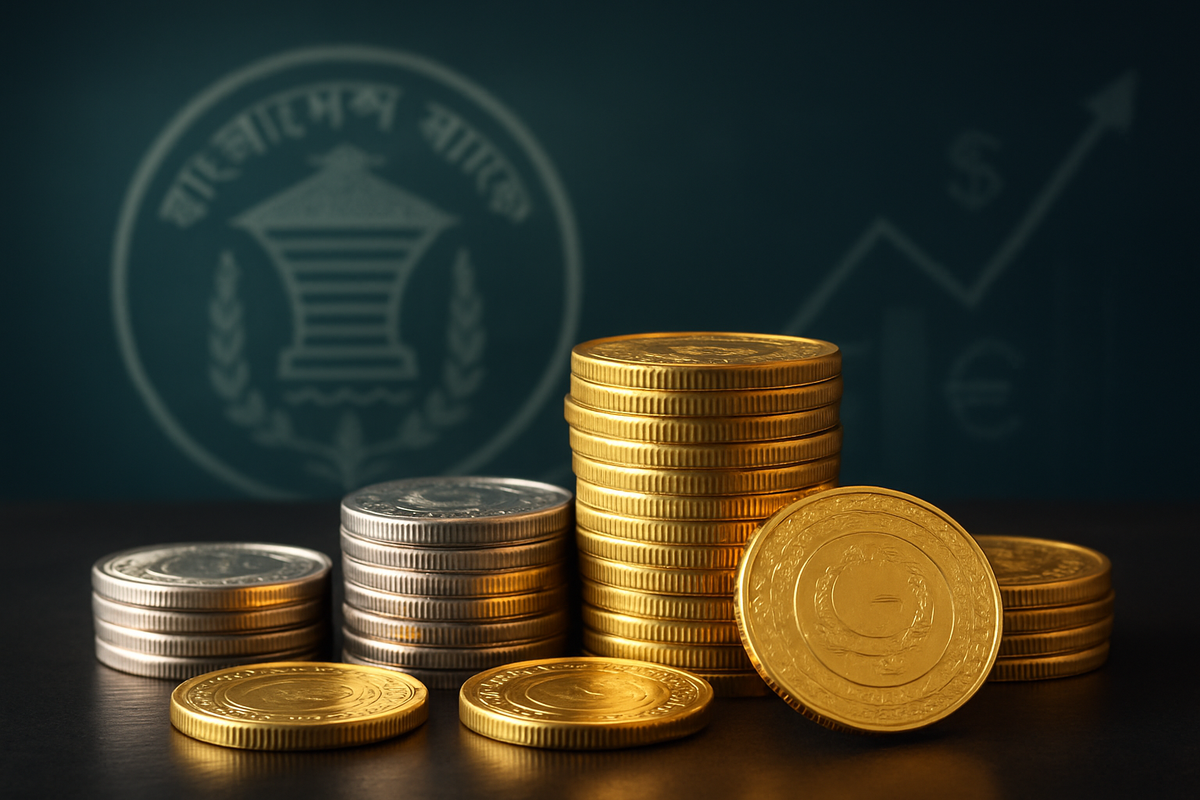
Dhaka, Bangladesh – November 18, 2025 – In a move reflecting the relentless upward trajectory of precious metal values, the Bangladesh Bank today announced a significant readjustment of prices for its commemorative gold and silver coins. This decision, effective immediately, sees the price of each commemorative gold coin climb to Taka 185,000, while commemorative silver coins are now priced at Taka 14,000. The central bank cited the continuous surge in both international and local bullion markets as the primary catalyst for this revision, aiming to align the official pricing of its special issues with prevailing market rates.
The immediate implication of this readjustment is a higher entry cost for collectors and investors interested in these unique numismatic pieces, which often commemorate significant national milestones. While the central bank's actions are a direct response to market realities, they underscore the broader economic environment where precious metals are increasingly seen as a crucial hedge against inflation and currency depreciation, a narrative gaining traction in Bangladesh's current financial climate.
The Central Bank's Response to a Volatile Market
The November 18, 2025, decision by the Bangladesh Bank (BB) is the latest in a series of frequent price revisions for its commemorative coins, a pattern that has intensified over the past few years. This proactive approach by the central bank aims to maintain the intrinsic value of these special issues in line with the highly volatile global and domestic precious metal markets. For instance, the price of a 22-carat, 10-gram gold commemorative coin has seen multiple increases: from Tk 78,000 in January 2023, to Tk 1,15,000 by August 2024, Tk 170,000 by September 2025, and now Tk 185,000. Similarly, silver coin prices have escalated from Tk 5,000 in early 2023 to Tk 14,000 today. These adjustments are formally announced via press releases from the central bank's Department of Communications and Publications.
Key players in this ecosystem extend beyond the Bangladesh Bank. The Bangladesh Jewellers' Association (BAJUS), a prominent industry body, plays a significant role in setting local gold prices for standard bullion, often reacting to international trends. Their frequent adjustments serve as a benchmark that indirectly influences the central bank's decisions. Consumers, who purchase these coins for collection, gifting, or investment, are directly impacted, as are investors seeking tangible assets. While not directly involved in daily price setting, the Ministry of Finance provides overarching policy guidance. Internationally, major bullion markets like the London Bullion Market Association (LBMA) and COMEX are crucial external stakeholders, as their price movements are consistently cited by the Bangladesh Bank as the primary driver for domestic adjustments.
The underlying reason for these adjustments is the significant and sustained surge in both local and international gold and silver prices. Globally, factors such as persistent inflation, geopolitical instability, and central bank gold accumulation (with central banks being net buyers for three consecutive years through 2024) have propelled prices upward. Locally, the market has seen 22-Karat gold reach over Tk 208,272 per bhori (11.664 grams) by November 2025, with silver at Tk 2,099 per bhori. This continuous upward trend, exacerbated by a local dollar crisis hindering formal imports and fostering a reliance on informal channels, creates an environment where the central bank must constantly recalibrate its pricing to reflect the true market value of the metals.
Market Implications: Winners and Losers
The Bangladesh Bank's consistent upward revision of commemorative coin prices, while seemingly a niche market event, sends clear signals across the broader precious metals landscape, creating potential winners and losers.
Consumers and Investors who have already acquired these commemorative coins stand to gain. Their assets have demonstrated significant appreciation, validating their decision to invest in tangible assets. For new investors, the rising prices reinforce the appeal of precious metals as a strong hedge against inflation and currency depreciation, especially in an economy grappling with high inflation (which has touched 11.66%) and dwindling foreign exchange reserves. However, the increased cost makes these coins less accessible to a broader segment of the population, potentially narrowing the collector base.
Local Jewelers, while not directly trading commemorative coins, are indirectly affected. The central bank's official price hikes reinforce the overall bullish sentiment in the precious metals market, potentially boosting consumer confidence in the long-term value of gold and silver. This can positively influence the perceived value of their inventory. However, the continuous rise in prices for all gold products, including commemorative coins, contributes to the growing unaffordability of new gold jewelry for the general public. This impacts sales volumes for jewelers, forcing many to adapt their business models towards lighter designs, silver products, or service-oriented offerings like repairs and redesigns. Jewelers also face the ongoing challenge of a constrained formal gold supply due to import difficulties and high duties, often relying on recycled gold or informal channels.
The Bangladesh Bank itself, as the issuer, benefits by maintaining the credibility and market relevance of its commemorative issues, ensuring their prices reflect underlying metal values. This helps preserve the integrity of its numismatic programs. While specific mint partners are not publicly detailed, any mint producing these coins would likely see consistent demand and revenue streams, albeit needing to manage their own raw material procurement at fluctuating international prices.
Wider Significance and Broader Trends
The Bangladesh Bank's decision to frequently adjust the prices of its commemorative gold and silver coins is a microcosm of broader industry trends concerning central bank strategies, inflation hedging, and monetary policy in developing economies.
Globally, central banks are increasingly accumulating gold as a strategic reserve asset. This trend, driven by geopolitical hedging, diversification away from the US dollar, and the search for stable stores of value amidst economic uncertainty, has seen central banks purchasing over 1,000 tonnes annually for the past three years. Bangladesh's actions, though on a smaller scale with commemorative coins, align with this global recognition of gold's importance in managing national assets and reserves. The country held 14 tonnes of gold reserves as of April 2023, reflecting its commitment to this trend.
The consistent price adjustments are a direct response to persistent inflationary pressures, both globally and domestically. Gold's historical role as a reliable hedge against inflation makes it particularly attractive in Bangladesh, where the national currency, the Taka, has faced depreciation. By aligning commemorative coin prices with market rates, the central bank implicitly acknowledges gold's function as a store of value that preserves purchasing power.
From a monetary policy perspective, the Bangladesh Bank's actions signal a broader intent to bring transparency and accountability to the precious metals market. The central bank is actively formulating a new policy to regulate the import of gold, silver, and jewelry, aiming to curb smuggling, improve transparency, and manage foreign currency outflows. This regulatory push, clarifying that only BB-authorized dealers can import gold, could set a precedent for increased oversight and regulation in other high-value commodities or financial instruments susceptible to informal markets and illicit trade. This focus on formalizing the gold trade is a common challenge for many developing economies, with countries like India having undertaken similar initiatives to legitimize their gold markets.
What Comes Next: A Glimpse into the Future
The recent price adjustments by the Bangladesh Bank are likely to set the stage for several short-term and long-term developments in Bangladesh's precious metals market.
In the short term, the immediate validation of rising gold and silver values could encourage more consumers to sell their old gold, capitalizing on the high prices. For collectors, these coins may become even more attractive as a store of value. However, the continuous price hikes will likely further dampen the demand for new, traditional gold jewelry, pushing jewelers to innovate their offerings.
Looking into the long term, precious metals, especially gold, are expected to solidify their role as a primary hedge against inflation and currency depreciation in Bangladesh. This will likely attract a growing base of long-term investors. The persistent challenges of informal trade and price disparities between local and international markets will intensify pressure on the government and the Bangladesh Bank to formalize import processes, streamline regulations, and potentially establish a commodity exchange system. This could lead to a more transparent and efficient market. We may also see continued growth in digital gold investment platforms, making gold more accessible to a wider demographic as an investment tool.
Strategic pivots will be crucial for local jewelers. They will need to diversify product lines towards lighter, design-centric pieces, explore alternative materials, and emphasize service-oriented business models. Embracing digital platforms and advocating for a national hallmarking system will be vital for building trust and reaching new customer segments. Investors will need to strategically allocate more to precious metals in their portfolios, monitor global and local policy changes, and consider diversification into silver, given its growing industrial demand.
Emerging market opportunities include the growth of a local gold refining industry (such as the Bashundhara Group's project), which could add value and reduce import reliance. There's also a significant opportunity for businesses offering gold testing, certification, and hallmarking services to enhance consumer trust. Furthermore, the expansion of digital gold investment platforms and the potential for exporting value-added jewelry could open new avenues for growth. However, challenges persist, including price volatility, the ongoing battle against illegal trade, the affordability crisis impacting traditional demand, and the persistent dollar crisis hindering formal imports.
A Market in Transition: The Road Ahead
The Bangladesh Bank's decision to readjust commemorative coin prices is a clear indicator of a precious metals market in flux, driven by powerful global and local economic forces. It underscores the central bank's commitment to aligning its official issues with market realities and its broader role in managing national assets amidst inflationary pressures.
The key takeaway is that gold and silver are increasingly viewed not just as ornamental assets but as critical investment tools and hedges against economic uncertainty in Bangladesh. This shift will continue to reshape consumer behavior, business strategies for jewelers, and the regulatory landscape. Investors should closely monitor global gold and silver price trends, the Bangladesh Bank's evolving policies on imports and reserves, and any governmental initiatives aimed at formalizing the precious metals market. These factors will determine the market's stability, accessibility, and long-term growth trajectory in the coming months and years. The ongoing efforts to curb illicit trade and enhance transparency will be pivotal in shaping a more robust and equitable precious metals ecosystem in Bangladesh.
This content is intended for informational purposes only and is not financial advice





